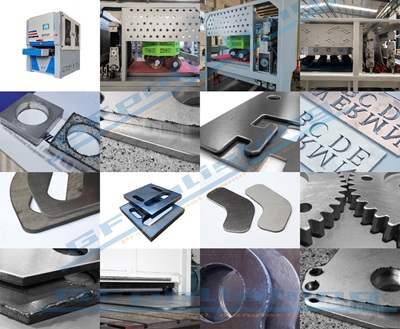Sac metal imalatı, ince, düz metal parçalarından parça ve yapıların oluşturulmasını içeren modern imalatın temel taşlarından biridir. Ancak bu sürecin genellikle gözden kaçan bir yönü de çapak almanın önemidir. Çapağı alınmamış sac metal, yalnızca nihai ürünün kalitesini değil aynı zamanda güvenliği, işlevselliği ve maliyet verimliliğini de etkileyerek ciddi sonuçlara yol açabilir.
Çapak alma kesildikten, damgalandıktan veya işlendikten sonra metalin kenarlarından çapak olarak bilinen küçük kusurların giderilmesi işlemidir. Bu çapaklar tipik olarak pürüzlü kenarlar, küçük çıkıntılar veya çeşitli imalat süreçleri sırasında ortaya çıkabilen artık malzemelerdir. Çapak alma işlemi manuel törpüleme, taşlama, yuvarlama veya özel çapak alma makineleri kullanma gibi çeşitli yöntemlerle gerçekleştirilebilir.
Çapak alma için her biri farklı malzeme türlerine ve üretim ölçeklerine uygun çeşitli yöntemler vardır. Eğe ve zımpara kağıdı gibi aletlerin kullanıldığı manuel çapak alma, küçük ölçekli işlemler veya karmaşık parçalar için etkilidir. Mekanik çapak alma, şunları içerir taşlama ve zimparalama maki̇neleri̇büyük ölçekli üretim için uygundur ve tutarlı sonuçlar sunar. Çapakları gidermek için kontrollü bir patlama kullanan termal çapak alma, karmaşık parçalar için etkilidir ancak özel ekipman gerektirir. Aşındırma çözeltilerinin kullanımını içeren kimyasal çapak alma, hassas veya hassas bileşenler için idealdir.
Teknolojideki gelişmeler, manuel yöntemlere göre çeşitli avantajlar sunan otomatik çapak alma sistemlerinin geliştirilmesine yol açmıştır. Otomatik çapak alma makineleri büyük hacimli parçaları hızlı ve tutarlı bir şekilde işleyerek işçilik maliyetlerini ve insan hatalarını azaltabilir. Bu sistemler üretim hatlarına entegre edilebilir ve çapak alma işleminin ek işlem gerektirmeden üretim sürecinin bir parçası olarak gerçekleştirilmesini sağlar. Otomasyon ayrıca daha fazla hassasiyet sağlayarak karmaşık geometrilerde yüksek kaliteli yüzeyler elde etmeyi mümkün kılar.

Güvenlik Tehlikeleri
Sac metalin çapaklarının alınmamasının en acil ve önemli sonuçlarından biri güvenlik tehlikesi potansiyelidir. Çapaklar keskin ve pürüzlü olabilir, bu da metali işleyen işçiler için ciddi bir yaralanma riski oluşturur. Kesikler ve yırtılmalar, ham ve çapaksız metalle çalışmayla ilişkili yaygın yaralanmalardır. Güvenliğin her şeyden önemli olduğu endüstriyel bir ortamda çapak alma işleminin ihmal edilmesi, işyeri kazalarının artmasına ve ardından daha yüksek tıbbi maliyetlere ve üretkenlik kaybına yol açabilir.
Ürün Kalitesi Üzerindeki Etkisi
Çapak alma, nihai ürünün kalitesini ve performansını sağlamak için çok önemlidir. Çapaklar montaj sürecine müdahale ederek parçaların doğru şekilde bir araya getirilmesini zorlaştırabilir. Bu da kötü hizalamaya, boşluklara ve zayıf bağlantılara yol açarak ürünün yapısal bütünlüğünü tehlikeye atabilir. Havacılık ve otomotiv üretimi gibi hassasiyetin kritik olduğu sektörlerde, küçük kusurlar bile ürün arızası dahil olmak üzere önemli sorunlara yol açabilir.
İşlevsel Çıkarımlar
Çapaklar, fiziksel zarar ve kalite sorunlarının ötesinde ürünün işlevselliğini de etkileyebilir. Örneğin, elektrikli bileşenlerde çapaklar istenmeyen elektrik yolları oluşturarak kısa devrelere veya arızalara yol açabilir. Mekanik parçalarda çapaklar sürtünme ve aşınmanın artmasına neden olarak bileşenlerin kullanım ömrünü azaltabilir. Ayrıca çapaklar kir ve nemi hapsederek korozyona ve metalin daha fazla bozulmasına yol açabilir.
Estetik Hususlar
İşlevsel ve güvenlikle ilgili endişelere ek olarak, çapak alma ihmal edilirse bir ürünün estetik kalitesi de önemli ölçüde düşebilir. Pürüzlü, bitmemiş kenarlar nihai ürünün görünümünü bozabilir, bu da özellikle tüketim mallarında ve görünür parçalarda önemlidir. İyi işlenmiş bir ürün sadece daha profesyonel görünmekle kalmaz, aynı zamanda üreticinin kalitesini ve detaylara verdiği önemi de yansıtır.
Maliyet Etkileri
Çapak alma işlemi üretim sürecine ek bir adım eklese de, ihmal edilmesi uzun vadede daha yüksek maliyetlere yol açabilir. Çapaklar nedeniyle kalite kontrollerinden geçemeyen ürünlerin yeniden işlenmesi veya hurdaya çıkarılması gerekebilir, bu da malzeme ve işçilik israfına yol açar. Ayrıca çapaklı olarak satılan ürünler, garanti taleplerinin ve müşteri memnuniyetsizliğinin artmasına neden olabilir ve sonuçta üreticinin itibarına ve karlılığına zarar verebilir.
Çevresel Hususlar
Çapak alma işlemlerinin çevresel etkileri de olabilir. Mekanik ve termal çapak alma yöntemleri genellikle toz ve metal talaşı gibi atık malzemeler üretir ve bunların çevre kirliliğini önlemek için uygun şekilde yönetilmesi gerekir. Kimyasal çapak alma, potansiyel olarak tehlikeli maddelerin kullanımını içerir ve çevresel zararı önlemek için dikkatli kullanım, depolama ve bertaraf gerektirir. Metal atıkların geri dönüştürülmesi ve çevre dostu kimyasalların kullanılması gibi çevre dostu çapak alma uygulamalarının hayata geçirilmesi, bu etkilerin azaltılmasına yardımcı olabilir ve sürdürülebilir üretime katkıda bulunabilir.
Eğitim ve En İyi Uygulamalar
Çalışanlar için uygun eğitim, etkili çapak alma işleminin sağlanmasında çok önemlidir. Çalışanlar çapakları tanımlama ve farklı malzemeler ve parçalar için uygun çapak alma tekniklerini kullanma konusunda eğitilmelidir. Çapak alma ekipmanının rutin bakımı ve çapak alma kontrollerinin üretim iş akışına dahil edilmesi gibi en iyi uygulamaların oluşturulması, yüksek kalite standartlarının korunmasına ve çapak alınmamış metalin olumsuz etkilerinin önlenmesine yardımcı olabilir.

Üretim teknolojileri gelişmeye devam ettikçe çapak alma alanında da ilerlemeler görülüyor. Robotik ve yapay zeka alanındaki gelişmeler, giderek daha karmaşık hale gelen parçaları daha hassas bir şekilde işleyebilen daha sofistike otomatik çapak alma sistemlerine yol açmaktadır. Ayrıca malzeme bilimindeki yenilikler, daha verimli ve çevre dostu yeni çapak alma araçları ve yöntemleri üretiyor. Bu trendler çapak alma işlemini geliştirerek modern üretimin daha ayrılmaz bir parçası haline getirecek.
Sac metal imalatında çapak almanın önemi abartılamaz. Bu kritik sürecin ihmal edilmesi, güvenlik tehlikeleri, ürün kalitesinin düşmesi, işlevsel arızalar, estetik sorunlar ve artan maliyetler gibi ciddi sonuçlara yol açabilir. Çapak almanın önemini anlayarak, etkili yöntemler uygulayarak ve endüstri standartlarına bağlı kalarak üreticiler yüksek kaliteli, güvenilir ve güvenli metal ürünlerin üretilmesini sağlayabilir. Teknoloji ilerledikçe, çapak almanın geleceği daha da fazla verimlilik ve hassasiyet vaat etmekte ve üretim ortamındaki temel rolünü güçlendirmektedir.
Siteyi kullanmaya devam ederek aşağıdakileri kabul etmiş olursunuz GİZLİLİK POLİTİKASI Şartlar ve Koşullar.